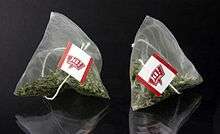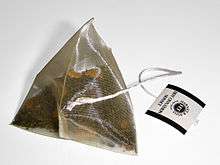Tea bag


A tea bag is a small, porous, sealed bag containing dried plant material, which is immersed in boiling water to make a hot drink. Classically these are tea leaves (Camellia sinensis), but the term is also used for herbal teas (tisanes) made of herbs or spices. Tea bags are commonly made of filter paper or food-grade plastic, or occasionally of silk. The bag contains the tea leaves while the tea is steeped, making it easier to dispose of the leaves, and performs the same function as a tea infuser. Some tea bags have an attached piece of string with a paper label at the top that assists in removing the bag while also displaying the brand or variety of tea.
In countries where the use of loose tea leaves is more prevalent, the term "tea bag" is commonly used to describe paper or foil packaging for loose leaves. They are usually square or rectangular envelopes with the brand name, flavour and decorative patterns printed on them.
History
In China, during the Tang Dynasty (618–907), paper was folded and sewn into square bags to preserve the flavor of tea.[1]
The first Western tea bags were hand-sewn fabric bags; tea bag patents date as early as 1903.[2] First appearing commercially around 1904, tea bags were successfully marketed by the tea and coffee shop merchant Thomas Sullivan from New York, who shipped his tea bags around the world. The loose tea was intended to be removed from the sample bags by customers, but they found it easier to brew the tea with the tea still enclosed in the porous bags.[3] Modern tea bags are usually made of paper fibre. The heat-sealed paper fiber tea bag was invented by William Hermanson,[4] one of the founders of Technical Papers Corporation of Boston. Hermanson sold his patent to the Salada Tea Company in 1930.
The rectangular tea bag was not invented until 1944. Prior to this, tea bags resembled small sacks.[5]
Production
Teas
A broad variety of teas as well as other infusions like herbal teas, are available in tea bags. Typically, tea bags use fannings, the left-overs after larger leaf pieces are gathered for sale as loose tea, but some companies sell teabags containing whole-leaf tea.[6]
Paper
Tea bag paper is related to paper found in milk and coffee filters and is a blend of wood and vegetable fibers. The latter is bleached pulp abaca hemp, a plantation banana plant grown for its fiber, mostly in the Philippines and Colombia. Some bags have a heat-sealable thermoplastic such as PVC or polypropylene as a component fiber on the inner tea bag surface.
Tea bag manufacturing machines
A few of the leading tea bag production machine companies are MAI from Mar del Plata, Argentina;[7] Teepack from Meerbusch, Germany;[8] and IMA, from Bologna, Italy.[9] A standard machine produced by the MAI company can fill 120 rectangular bags per minute[10] containing up to 3.3 grams per bag, which allows the packaging of herbal teas. Another company, the Italian Tecnomeccanica, has a faster design capable of filling 250 tetrahedral bags per minute.[11]
Shapes and use


Traditionally, tea bags have been square or rectangular in shape. More recently circular and tetrahedral bags have come on the market and are often claimed by their manufacturers to improve the quality of the brew. Environmentalists prefer silk to nylon because of health and biodegradability issues.[12] Another material for tea bags is Soilon, made from corn starch.[13] Empty tea bags are also available for consumers to fill with tea leaves themselves. These are typically open-ended pouches with long flaps. The pouch is filled with an appropriate quantity of leaf tea and the flap is closed into the pouch to retain the tea. Such tea bags combine the ease of use of a commercially produced tea bag with the wider tea choice and better quality control of loose leaf tea.
Coffee bags
The concept of pre-measured portions to be infused in disposable bags has also been applied to coffee in the form of coffee bags, although this has not achieved such wide acceptance as tea bags.
Tea bag-related activities
Decorative tea bag labels have become the basis for large collections and many collectors collect tea bags from around the world.
Teabag folding began in the Netherlands and is often credited to Tiny van der Plas. It is a form of origami in which identical squares of patterned paper (cut from the front of tea bag wrappers) are folded, and then arranged in rosettes. These rosettes are usually used to decorate gift cards and it has become a popular craft in both the US and UK since 2000.[14]
See also
- 3-MCPD, a chemical compound that is carcinogenic, and can occur in some resin-reinforced tea bag materials
- Builder's tea, refers to a basic method of preparing tea in a mug with tea bags
- Tea leaf grading
- Tea strainer, a small mesh utensil that can filter out stray tea leaves when whole-leaf tea is poured from a teapot
- Tetley, the British tea company that introduced tea bags in the United Kingdom in 1953
References
- ↑ Tsien, Tsuen-Hsuin (1985). Paper and Printing. Joseph Needham, Science and Civilisation in China, Chemistry and Chemical Technology. Vol. 5 part 1. Cambridge University Press. p. 122.
- ↑ "Tea-leaf holder". USPTO. Retrieved 25 October 2013. US patent 723287 was issued on MAR. 24, 1903 to R. G.LAWSON & M. McLAREN for a 'novel tea-holding pocket constructed of open-mesh woven fabric, inexpensively made of cotton thread'.
- ↑ Editors, Time-Life (1991). Inventive Genius. New York: Time-Life Books. p. 99. ISBN 0-8094-7699-1.
- ↑ Bloxham, Andy (2008-06-13). "Tea bag to celebrate its century". Telegraph.co.uk. Retrieved 2009-07-15.
- ↑ Dubrin, Beverly (2010). Tea Culture: History, Traditions, Celebrations, Recipes & More. Charlesbridge Publishing, p. 35. ISBN 1607343630
- ↑ Fabricant, Florence (2000-02-09). "Whole Leaves, No Strings For a New Tea Bag". The New York Times. Retrieved 2009-07-15.
- ↑ "Mai S.A". Mai S.A. Retrieved 2009-07-15.
- ↑ "TEEPACK GmbH & Co. KG". Teepack. Retrieved 2010-02-17.
- ↑ "IMA Tea & Coffee Division". Ima.it. Retrieved 2009-07-15.
- ↑ "Maisa Tea Bagging". Allianceindia.net. Retrieved 2009-07-15.
- ↑ "Faster tea-bagging machine". Foodproductiondaily.com. Retrieved 2009-07-15.
- ↑ Fabricant, Florence (September 13, 2006). "Tea's Got a Brand New Bag". The New York Times.
- ↑ Tea Stick Brewing Package and Method
- ↑ jbritton (2009-06-29). "Tea bag folding". Britton.disted.camosun.bc.ca. Retrieved 2009-07-15.